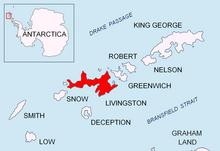



Castra Martis Hill (Halm Kastra Martis \'h&lm 'kas-tra 'mar-tis\) is a 453 m hill near Leslie Hill in Livingston Island. The peak was named after the Roman settlement of Castra Martis, ancestor of the present town of Kula in Northwestern Bulgaria.
First ascent by the Bulgarians Lyubomir Ivanov and Doychin Vasilev from Camp Academia on 25 December 2004, as part of Tangra 2004/05 survey.
YouTube Encyclopedic
-
1/2Views:23 778927
-
Крепости в България
-
RK Studio Taller de Técnica Vocal - Sofía Rojas
Transcription
Bulgaria's Strongholds Many civilizations had lived on the territory of Bulgaria. The local residents were in a constant battle with invaders, trying to conquer it. That is why its territory is covered with historical remains and fortresses, which had left a bright trace in history. Fortresses with inaccessible walls, naturally added to the relief, which had long preserved the Bulgarian spirit. Without a doubt Tsarevets is the pearl in the crown of fortresses. Behind the walls of this unconquerable fortress was raising the Palace complex, where for a period of three centuries the Bulgarian tsars ruled the country. Even in the present day visitors can see the remains of the Throne Hall, The Palace Church, the Royal Bedroom, residential and agricultural buildings, and a water storage room. Protected by an external stone wall, with two military towers and two entrances, the complex is situated behind strong fortified walls. The Bulgarian fortresses often use the natural protection of high mountain ridges. That is why the Asenova Fortress was built on the rock banks, overhanging the Asenitsa river. The ancient fortress acquired the greatest importance during the reigning of Joan Asen II in the 13th century. The walls were built according to the relief of the rock massif, and the citadel had preserved a tower, a water reservoir and a chapel, with unique frescos, which had preserved history in the past times. The Lovech medieval fortress "Hisarya" is also soaked with history. The peace treaty between Bulgaria and Byzantium was signed inside it in 1187. Through it was acknowledged the Second Bulgarian State. It was a residence of Ivan Alexander and it was one of the last fortresses, conquered by the Ottoman Empire. Another fortress - Ovech, near the town of Provadia, reminds about the unbreakable Bulgarian spirit. It is situated on a high rock plateau, accessible only along a rocky edge, two steps wide, on which an excavation is made. A movable bridge was being descended here, but presently only the front door and the stone wall beside it have been preserved. The legends says that in the caves under the fortress there was a great amount of reserves of grain and food. In southern Bulgaria there are multiple fortresses, related to the Crusades. Monyak, situated near the town of Kardzhali, is an inaccessible cliff where the knights elected an emperor - a heir of the captured Baudouin de Flandreau. An important road passes by Ustra, built on a steel hill in the municipality of Dzhebel. A real handbook of defense is the stronghold near the village of Mezek with its nine mighty towers. The Danube fortress "Kastra Martis", looks as if it reflects the destiny of the collapsing Roman Empire. Another empire - the Ottoman - used Medzhiya Tabiya, near Silistra, for a supporting point during the Crimean War. It is believed that the Pernik fortress dates back to the 9th century - during the reigning of Khan Omurtag. Archaeologists had found remains which indicate that the fortress at this place had existed as early as the 6th - 5th century BC. It is most often related to the name of the military leader Krakra of Pernik during whose ruling the fortress manifested crucial resistance against the Byzantine seizure. But probably the most intriguing is the medieval town of Cherven. Surrounded by a strong wall, it was completely unreachable for its enemies. Diverse economic and religious center was being developed behind its walls. The fortress was a real shelter for crafts, as well as a commercial center. But as every fortress, this one also had a weak spot. Set on fire, and completely burned down by the Ottoman troops, it fell into oblivion to the previous century. Presently its magnificence is indicated only by the ruins of the tower of the Cherven boyar.
Location
The hill is located at 62°34′14.4″S 60°11′37.5″W / 62.570667°S 60.193750°W which is 550 m east by southeast of Leslie Hill and the peak is linked to it by a saddle of 418 m elevation.
Maps
- L.L. Ivanov et al. Antarctica: Livingston Island and Greenwich Island, South Shetland Islands. Scale 1:100000 topographic map. Sofia: Antarctic Place-names Commission of Bulgaria, 2005.
- L.L. Ivanov. Antarctica: Livingston Island and Greenwich, Robert, Snow and Smith Islands. Scale 1:120000 topographic map. Troyan: Manfred Wörner Foundation, 2009.
- A. Kamburov and L. Ivanov. Bowles Ridge and Central Tangra Mountains: Livingston Island, Antarctica. Scale 1:25000 map. Sofia: Manfred Wörner Foundation, 2023. ISBN 978-619-90008-6-1
References
- Castra Martis Hill. SCAR Composite Gazetteer of Antarctica
- Bulgarian Antarctic Gazetteer. Antarctic Place-names Commission. (details in Bulgarian, basic data in English)
External links
- Castra Martis Hill. Copernix satellite image
This article includes information from the Antarctic Place-names Commission of Bulgaria which is used with permission.
